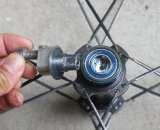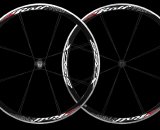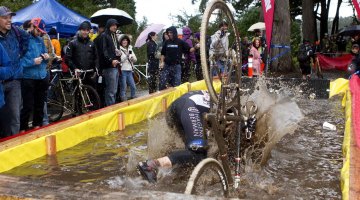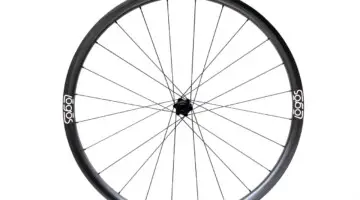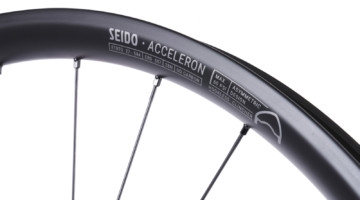by Andrew Yee
You know singlespeed cyclocross racing has become popular when your local series has two categories and field limits, there’s a “world championship” event, and a company like Rolf Prima releases a cyclocross-specific singlespeed wheelset. All for good reason, as singlespeeds are simple, light and allow you to focus more on just pedaling as fast as you can.
Curious? Giving singlespeed cyclocross racing a try doesn’t require a dedicated bike – singlespeed conversion is easy [see our conversion how-to], even if just for one event. But once you find that the singleminded-nature and simplicity of riding one gear is appealing, you may find yourself heading down the path of acquiring dedicated equipment and even spare bikes.
The Specs
Rolf has recognized the growth of this segment of cyclocross and now offers no less than seven different wheel configurations for cyclocross. The SSCX wheelset is a modified version of its VCX cyclocross wheel (reviewed in Cyclocross Magazine Issue 7) but is customized for the singlespeed racer. I had a chance to ride and review an early pair of these specialized wheels from Rolf over the last few weeks.The SSCX wheelset comes in two rear hub configurations: with a standard rear ENO hub that retails for $749, or an eccentric ENO hub to allow for chain tension adjustment that retails for $799. Both ENO hubs are made for Rolf by White Industries. For rims, just like with the VCX wheel, you can now choose between a clincher and tubular.
The wheels feature a 31mm deep sectioned aluminum rim that’s 21mm wide, outside-to-outside. That’s about 2mm wider than the “standard” Mavic Open Pro clincher rim. The front hub is Rolf’s own dF3.4. But the real story is the rear ENO hubs. The eccentric option allows 15mm of total horizontal adjustment to tension your chain. That’s quite a bit and allows a few different cog sizes without requiring a chain length adjustment, given that a one tooth increase (or decrease) in rear cog requires just over 3mm of adjustment.
Either the eccentric version or standard ENO hub has a flip-flop option, one side for a singlespeed freewheel, and the other side for a fixed gear, should normal freewheel-based singlespeed cyclocross become too mainstream for you and you want to give fixed gear cyclocross a try (see our article on this: FixieCross: Equal Parts Ridiculous and Zen). The fixed gear side requires a proprietary splined cog from White Industries but is locked into place by a simple lock ring.
Of course, the Rolf’s unique paired spoke lacing pattern deserves mention. It’s been proven in the Tour de France, has aerodynamic benefits and ends up using fewer spokes. And it creates big gaps between spoke pairs for a unique look.
Setting the SSCX Wheels Up
The White Industries-made ENO hub accepts a rear freewheel or proprietary splined fixed gear cog. © Cyclocross Magazine
I tested a set of the $799 SSCX with the eccentric hub option. I had a Bianchi Cross Concept set up for singlespeed racing with a tensioner and a singlespeed cog and spacers on a rear road wheel. To install the SSCX rear wheel, I took off my rear wheel, about 100 grams of tensioner and a few chain links. To get up and running, I needed to get a singlespeed freewheel, and used a standard Shimano BMX 18 tooth freewheel for a 3/32” chain (about $20 at your local bike shop – check there first – or widely available online). If you know you’re dedicated to the one gear movement for life, there are fancier freewheel options, including White Industries’ sealed cartridge bearing freewheel that retails for $95.
Many singlespeeders choose one gear and ride it regardless of the course, and I tend to fall in that category. But it’s important to note that if you’re the type of singlespeeder that heads to a race armed with a slew of cogs to find the perfect gearing for every situation, this may not be your wheel, as you’ll need be armed with freewheels, not cogs, and removal of the freewheel takes considerably more effort than a cassette freehub cog, at least on a Shimano-compatible freewheel. The SSCX’s axle cap interferes with the Shimano removal tool, and so you need to remove that first with a 4mm Allen key. And removing a freewheel (at least for this weakling) always takes a lot of effort and grunting unless you’ve got a table-mounted vice – unlikely at a race.
The upside I discovered in this process is that the axle caps are replaceable, making it really easy to convert these from 130mm to 135mm spacing (or 126mm if you’ve got a retro road ride). Got a 29er in the garage that runs rim brakes? These would work just fine with different caps.
Setting the wheel up in my bike was surprisingly easy. After mounting and inflating a tire, I grabbed an adjustable wrench to hold the axle flats in the desired place and a 6mm Allen wrench to secure the bolts that clamp the wheel to the frame. You’ll need to ride with the Allen wrench in case of flats, but can get by in a pinch by finger-rotating the eccentric axle to adjust the chain. It’s of course good practice to ride with a multi-tool, but I’m the first to admit there are many times I forget it at home – now it becomes a necessity. It’s important to note that the rotating the axle does make slight changes to your bike’s geometry. Like rear-facing horizontal dropouts, the eccentric ENO hub changes the effective chainstay length, but also adds the ability to slightly adjust the height of the rear wheel. If you’re going to change rear freewheels frequently, you may have to adjust your brake pads.
The Ride
Once fully dialed, the rear wheel works like a cyclocross wheel should. I rode the wheel on a bunch of local trails, a practice race and in a local race down in Monterey. Despite a number of botched jumps, quite a few rocks and roots, a poor curb hop and some serious mashing up a painfully steep hill, the wheel held its place in the frame, was reasonably quiet, and spun true and round. Just as with the company’s VCX wheel, I was impressed with the durability – a good thing as the nipples are internal and require a tire removal for truing. I slammed a few course “features” hard enough to bottom out and pinch a tube, both front and rear, and the rim survived without a nick. The company is confident in their strength as there’s no rider weight limit for these wheels, and like the VCX, I think they’re an ideal build for the bigger guy.
Because I didn’t need a tensioner anymore, my drivetrain got both quieter and a bit smoother, as there wasn’t another pulley or roller to press up against the chain or add extra friction. That’s definitely a nice benefit.
Some racers are attracted to singlespeeding for the simplicity, but a few like it because bikes can be ultralight. Although you can save a little weight by removing your tensioner and shortening your chain, the SSCX wheels aren’t designed for weight weenies. At 1590 grams complete (we measured 1700 grams with rim strips and rear axle bolts) (50 grams less for the standard hub), they’re not the lightest wheels for sure, and take a little more effort to spin up than some light road wheels available at the price. That’s in part due to the beefy, deep section rim that provides the wheels’ durability (and aerodynamics if paired with a road tire). It’s also important to note that, unlike typical road wheels, the freehub is not included in the weight – you must factor in the weight of the freewheel, not just a cog. But the upside is that when conditions get nasty, a wrecked freehub won’t ruin your wheels as you can easily replace the freewheel.
Once you get up to speed, you can ride with confidence – the braking track is machined and offers predictable braking. And the deeper rim profile may shed certain tights or mud should conditions get sloppy.
The front wheel, although not singlespeed specific, is quite nice and features a 200 gram hub. It’s the same wheel we reviewed with the VCX wheelset, and tips the scales around 700 grams.
Although we didn’t test this wheelset in a tubeless conversion set up, we did have success running the VCX wheels reviewed as tubeless with a Stans strip earlier and would guess these wheels, with the exact same rim as the VCX, would also work well (although neither Rolf nor Cyclocross Magazine endorses such use).
New for 2011 is Rolf’s alloy tubular rim option, and I suspect that many dedicated singlespeed cyclocross racers will opt for this. We did not have a chance to test this option. Curiously, unlike most wheelsets with tubular options, the SSCX wheels are actually about 60 grams heavier with a tubular rim.
The Verdict
The SSCX wheels are a very nice option for the serious singlespeeder. The eccentric hub provides an easy option to convert a cyclocross frame with vertical dropouts to singlespeed use. With a proven design and a strong rim, based on our two months of abuse, I think they will be plenty durable for many seasons of use. The external freewheel configuration ensures years of smooth coasting, but makes regular changing of rear cogs quite difficult.
They’re not the lightest option, and at $799 they’re more than some complete singlespeed cyclocross bikes. But if you’re serious about the sport and hard on your equipment, they’re definitely worth a look. With the SSCXWC just around the corner, Rolf’s SSCX wheels will have you already just two letters short of the Golden Speedo.
Rolf Prima Eccentric ENO Hub SSCX Wheelset
MSRP: $799
Rim: 31mm deep, 21mm wide alloy clincher (tubular available)
Rear Hub: ENO eccentric axle flip-flop hub, cartridge bearings, accepts singlespeed freewheel and White Industries splined fixed cogs, 6mm Allen clamp bolts, 345 grams (made by White Industries)
Front Hub: 200 grams, cartridge bearing
Spokes/Build: 16 spokes, paired lacing, front and rear. Assembled by hand in Eugene, Oregon
Weight: 1700 grams with rim strips, 720 grams front without quick release, 980 grams rear with bolts. (1595 grams list, 665g front, 960g rear)
For more info: http://www.rolfprima.com/products-SSCX.php
Photo Gallery:













